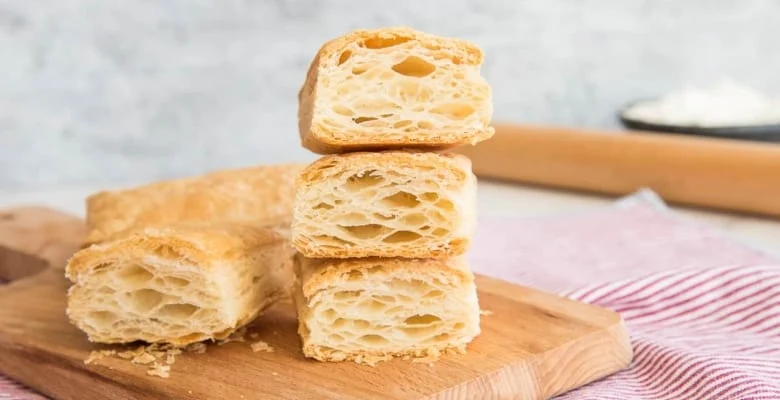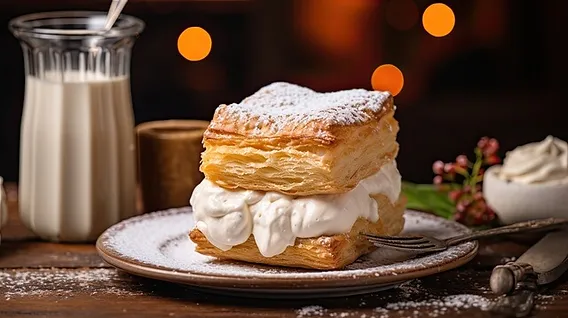Puff pastry is a versatile and delicious dough known for its flaky layers and delicate texture. Whether you’re preparing sweet or savory treats, mastering puff pastry from scratch can elevate your baking game. While it may seem like a challenging process, following the right techniques can lead to perfect results every time. Here are some key tips to help you bake puff pastry from scratch with confidence.

1. Use Cold Ingredients
The key to creating the light, flaky layers of puff pastry is keeping the dough cold throughout the process. Cold ingredients ensure that the butter remains solid as you roll the dough, creating distinct layers. Always use cold butter, and chill your flour, rolling pin, and workspace if necessary. This helps prevent the butter from melting prematurely and ensures the perfect puffing action in the oven.
2. Choose the Right Butter
High-quality butter is essential for making puff pastry that has great flavor and texture. Opt for unsalted butter with a high fat content, as it will contribute to a richer taste and help achieve the desired flakiness. Some bakers even use European-style butter, which has a higher butterfat percentage, for a more tender pastry.
3. Keep the Dough Relaxed
As you work with puff pastry dough, it’s important to allow it to rest frequently. This helps to relax the gluten, preventing the dough from becoming too tough. After each turn or roll, wrap the dough in plastic wrap and refrigerate it for at least 30 minutes. Resting between folds allows the dough to relax and helps maintain the structure needed for puffing.
4. Be Patient with the Folding Process
Puff pastry relies on creating multiple thin layers of dough and butter through a series of folds and turns. The process can seem time-consuming, but it’s necessary to achieve the signature puffed layers. Follow these steps:
- Roll out the dough into a rectangle shape.
- Fold it into thirds like a letter (this is called a “single turn”).
- Rotate the dough 90 degrees and repeat the process for a total of four single turns (or more, if desired).
Allow the dough to chill between each turn to keep the butter cold. Don’t rush this process—it’s the key to flaky, airy layers.
5. Avoid Overworking the Dough
While it’s important to fold the dough a few times, overworking the dough can cause it to become tough and dense. If you notice the dough becoming too sticky or soft, chill it for a longer period before continuing. Remember, puff pastry is all about balance. You need enough folds to create layers, but too much work can ruin the texture.
6. Roll the Dough Evenly
When rolling out puff pastry, aim for an even thickness throughout. This ensures that the layers bake uniformly, resulting in an evenly puffed pastry. If you roll too thin, the layers won’t form properly. If the dough becomes too soft or sticky while rolling, refrigerate it for 10–15 minutes before continuing.
7. Use the Right Technique for Cutting
When cutting puff pastry, use a sharp knife or pastry cutter to avoid crushing the layers. A dull blade can push down on the dough, causing the layers to stick together. If you’re using puff pastry for savory or sweet dishes like turnovers or palmiers, cut the dough into uniform shapes to ensure even baking.
8. Bake at a High Temperature
Puff pastry requires a hot oven to create the steam needed for the dough to rise and puff. Preheat your oven to 400°F (200°C) or higher, depending on your recipe. This high temperature helps the butter melt quickly, which in turn creates steam that causes the dough to rise in thin layers. Make sure the oven is fully preheated before placing your pastries inside.
9. Brush with an Egg Wash
For a golden, glossy finish, brush your puff pastry with an egg wash before baking. An egg wash is typically made from a beaten egg mixed with a small amount of water or milk. It gives the pastry a shiny, professional-looking finish and helps it develop a beautiful color as it bakes.
10. Don’t Open the Oven Door Too Early
During baking, it’s important not to open the oven door prematurely. Puff pastry relies on consistent, high heat to rise and puff. Opening the oven door can cause a drop in temperature, potentially affecting the rise of the dough. Wait until the pastries are golden and crisp before checking on them.
11. Use Puff Pastry for Sweet and Savory Dishes
Puff pastry is incredibly versatile and can be used for a variety of sweet and savory dishes. For sweet pastries, try filling the dough with fruit preserves, custard, or chocolate. For savory options, experiment with fillings like cheese, ham, or spinach. The layers of buttery dough will create a crisp, flaky texture that pairs perfectly with almost any filling.
12. Make Ahead and Freeze
Puff pastry can be made ahead of time and stored in the freezer. After completing the folding process, wrap the dough tightly in plastic wrap and freeze it for up to a month. When you’re ready to bake, simply thaw the dough in the refrigerator for a few hours before using it. This makes it easier to prepare puff pastry without needing to start from scratch every time.
Conclusion
Baking puff pastry from scratch requires time, patience, and attention to detail, but the results are worth it. By following these tips, you can create delicious, flaky puff pastry at home that can be used for a wide range of both sweet and savory recipes. Whether you’re making classic French pastries, turnovers, or fancy appetizers, mastering puff pastry will elevate your baking skills and delight your taste buds with its irresistible layers.


Excellent post. I was checking continuously this blog and I am impressed!
Very helpful info specifically the last part 🙂 I care for
such information a lot. I was looking for this particular information for a
very long time. Thank you and good luck.